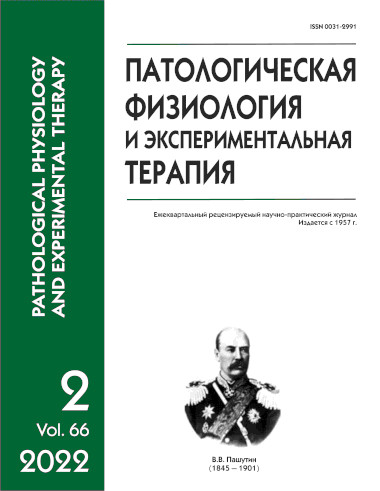Features of the mechanism of development and сourse of acute stroke in patients with COVID-19
Abstract
COVID-19 remains at the peak of urgent medical and social problems worldwide. Information has been continuously supplemented about the development of various complications in patients with the new coronavirus infection, including acute stroke that is a very common and often fatal pathology. Aim. To study the pattern of occurrence and mechanisms of development of ischemic stroke associated with COVID-19. Methods. The study included 60 patients with COVID-19. The main group consisted of 20 patients with ischemic stroke (IS) associated with COVID-19; the comparison group consisted of 40 patients with COVID-19 without IS; and the control group included 20 healthy volunteers. A comprehensive clinical and laboratory monitoring was performed for all patients. Concentrations of proinflammatory cytokines and C-reactive protein (CRP) and activities of matrix metalloproteases 2 (MMP-2) were measured in the serum by the immunochemical assay. Results. IS developed in 70% (n=14) of patients in the main group, generally between days 12 and 14 after the onset of infection. Twelve patients (57%) had an unfavorable course of stroke associated with COVID-19, often followed by multiple organ dysfunction syndrome (MODS). All 12 patients (100%) had various cardiovascular comorbidities. In the majority of patients with stroke followed by MODS significant changes in many clinical and laboratory indexes developed already during the first day of admission to the hospital. These changes included arterial hypertension (100% of patients), tachycardia (80% of patients), and significant increases in blood D-dimer (83% of patients), von Willebrand factor (75% of patients), interleukin-10 (92% of patients), tumor necrosis factor α (92% of patients), CRP (100% of patients), and the activity of matrix metalloproteinase-2 (100% of patients). Also, patients developed tachypnea, fever, leukocytosis, and hyperglycemia. Conclusion. COVID-19 and high cardiovascular comorbidity are significant risk factors for the development, adverse course, and unfavorable outcome of IS. A significant increase in proinflammatory cytokines (IL-10 and TNF-α), CRP and MMP-2 activity together with a combination of changes in clinical and laboratory parameters (tachycardia, tachypnea, fever, leukocytosis, hyperglycemia) are natural early predictors of acute MODS in IS patients with COVID-19. This indicates a similarity and mutual potentiation of key pathogenetic components: cytokine storm, acute respiratory distress syndrome, and MODS already in the acute period of IS.






